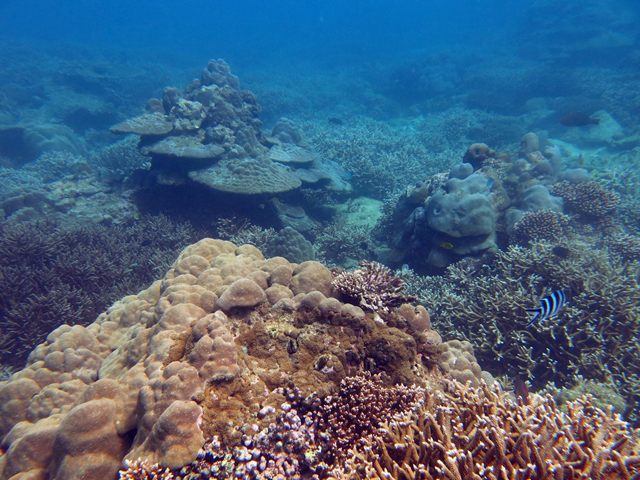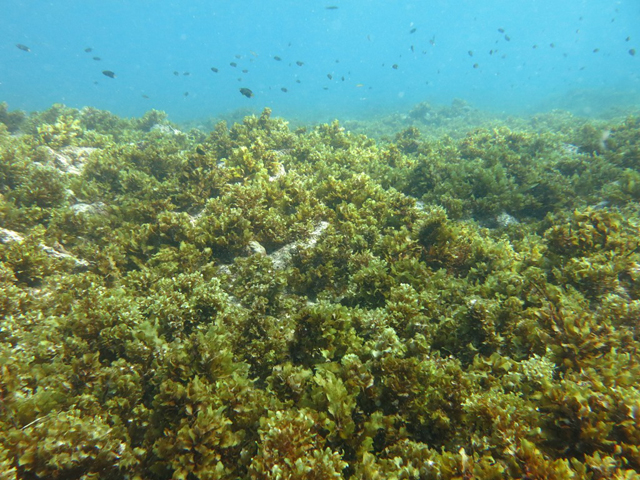Seychelles coral reefs just beginning to show signs of recovery, say researchers
General |Author: Hajira Amla | July 14, 2014, Monday @ 20:22| 18855 views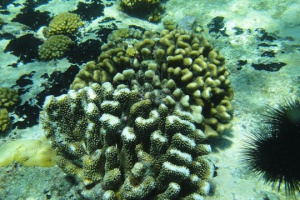
Researchers monitoring the condition of Seychelles' corals have observed that the islands coral reefs are beginning to show signs of recovery (Rodney Quatre)
(Seychelles News Agency) - Ten years after the ‘super’ El Niño weather phenomenon that caused a massive die-off in the delicate coral reefs around the inner islands of the Seychelles, researchers were concerned that they would never recover.
However, one Australian scientist who published a research paper last year believes that the coral reefs around the main islands of the Seychelles, almost completely decimated by consistently high sea temperatures in 1998, are showing slow but definite signs of new growth.
The 2008 study: a cause for concern
A study led by the research director at Blue Ventures Conservation, Alasdair Harris, in April 2008 assessed the composition of inner Seychelles coral communities 10 years after the El Niño event caused up to 95 percent of coral in the reefs to bleach and die.
The study was undertaken at 21 sites around the main inhabited islands of Mahé and Praslin, with three sites located in each of the two ‘no-take’ marine reserves around the islands: Ste Anne Marine Park, established in 1973 and the Cousin Island special reserve off Praslin, which was established in 1968 with fishing banned in 1975.
The results were worrying: the tiny coral larvae that drift into reefs, otherwise known as ‘new recruits’, and juvenile corals were not able to establish themselves densely enough on larger areas of reef, and the frameworks the corals use as a foundation were in many places heavily eroded. In some sites, particularly the sites surveyed around Praslin, seaweed and algae overgrowth threatened to overtake the reefs entirely.
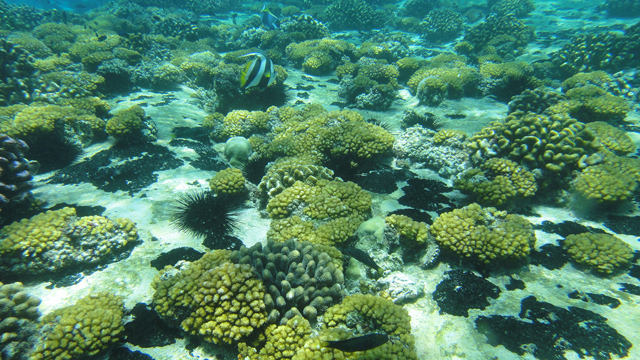 |
| Corals and recruits (Rodney Quatre ) Photo License: CC-BY |
In an email interview with SNA, Dr Harris explained that the Western Indian Ocean region was hit harder than anywhere else in the broader Indo-Pacific, with devastating mortality in many countries; and the inner islands of the Seychelles were no exception.
“The inner Seychelles seem to have been hit so badly in 1998 because of a number of factors, including: the region's bathymetry - it's a broad shallow bank that was bathed in warm water during the 98 El Niño event; the weather - clear skies, causing hot water during the 1998 El Niño event - contrasting for example with Mauritius which saw much milder conditions during the El Niño because of cloud cover caused by cyclone Anacelle; and the bank's relative geographic isolation from major currents providing sources of recruitment across the Indian Ocean,” explained Harris.
In contrast, the outer islands of the Seychelles archipelago, elaborated Harris, are generally atoll structures surrounded by deeper waters, which are likely to have provided some refuge for corals living in cooler, deeper water, which in turn were able to act as sources of new recruits that helped to re-seed degraded sites in shallower waters.
In the same vein it appears likely that the inner islands may have a heavy reliance on self-recruitment which Harris thinks may have hampered the recovery process in the inner Seychelles.
In addition to this, he says that many of the sites lack stable substrates or foundations suitable for recolonization by juvenile corals. To add insult to injury, once seaweeds begin to colonise the dead coral surfaces, it's very difficult for new coral recruits to get a foothold in the reef and begin the regeneration process.
“At a worrying number of coral reef sites across the inner Seychelles many of the reefs have shifted towards a stable, algal dominated phase, in which seaweeds hold sway on top of gradually collapsing dead coral frameworks - an eroding low diversity state maintained by low recruitment, a lack of stable hard substrate for juvenile corals to settle on, and possibly also by overfishing of key herbivorous fishes. The mobile substrates (rubble) left behind at many sites are another factor preventing further coral settlement,” said Harris.
New data gives new hope
Harris informed us that since his study in 2008, the same sites had been revisited by Australian researchers, Dr Nick Graham and Dr Shaun Wilson, as well as other colleagues, as recently as this year.
SNA spoke to Dr Graham, who confirmed that there is now “a lot more cause for optimism” than the 2008 data suggested. Although some sites have continued to degrade into rubble, others have exceeded expectations in terms of improvement.
“Since the 2008 surveys during which Alasdair Harris conducted his study, Dr Shaun Wilson and I have been back to monitor the condition of the corals and fish at the same 21 sites in 2011 and April this year,” Graham said.
“Around half of the sites that we surveyed are now recovering very well, and by 2014 had similar coral cover to pre-bleaching levels (based on surveys in 1994). In particular, the sites we survey along the north and west coasts of Mahé are recovering very well, as well as several other individual sites in the Ste Anne Marine Park and the north and south sides of Praslin.”
Sadly, the other half of the monitoring sites are not showing much sign of recovery at all, with continuing dominance of macroalgae and very little coral.
Seychelles researcher also monitoring closely
Seychellois Sylvanna Antha who is in charge of marine research and surveillance at the islands’ Marine Parks Authority has also been closely monitoring the corals and is of the same view as the international experts that indeed there is recovery of the Seychelles corals.
“All the variety of corals are recovering but what we have observed is that some species grows faster than others,” Antha told SNA.
“What we have also seen is that the new corals are proving to be more resistant when it comes to higher, they can better adapt to temperature that is higher than 31 degrees for a longer period of time.”
According to Antha, the growth of the corals is also bringing back some fish species that had disappeared from the islands’ coral reefs like the butterfly fish.
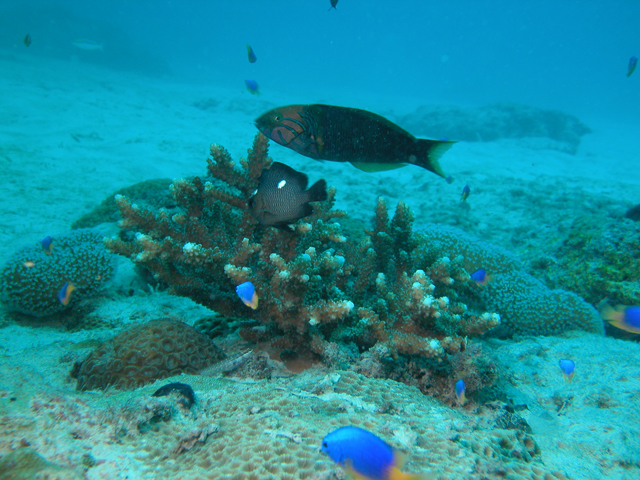 |
| corals and fish the recovery of the corals is also bringing back some fish species that had disappeared from the islands’ coral reefs- (Staghorn Coral project ) Photo License: CC-BY |
Recovery on Cousin Island
A coral reef rescue project on Cousin Island, started in 2010 by Nature Seychelles, financially supported by the United States Agency for International Development (USAID) uses a method called ‘reef gardening’ – taking bits of healthy corals from donor sites and raising them in underwater nurseries until they grow to required size, when they are ‘planted’ in degraded sites.
The project has so far proved itself to be a success, but there are three other sites around Cousin that have shown signs of natural recovery as well, a huge relief to the researchers given the high levels of mortality and degradation seen in the first ten years.
“In terms of Cousin Island Special Reserve, we did not specifically assess the coral restoration project, but from what I understand it has been very professionally conducted and they are having some success in transplanting and establishing corals in an area on one side of the island,” said Graham. “Cousin, with its other conservation successes, is a good place to trial an experiment like this, however the manpower and resources to conduct restoration at much larger scales around the Inner Seychelles is likely to be quite prohibitive.”
In short, although some Seychelles reefs remain heavily degraded from the 1998 bleaching event, we are finding cause for optimism that many reefs have the ability to recover from these major bleaching events, and reducing local sources of stress to these reefs should offer them the best chance of continuing to bounce back from any future bleaching events.
|
|
| Recovering reef -Seychelles (Nick Graham) Photo License: CC-BY |
Action needed to protect the reefs should be an ‘urgent national priority’
But it’s not all bad news, according to Harris. There is a lot that can still be done to help protect the sites that seem to be showing signs of long-term survival, but he says this will require “concerted action” at a national level, both by protected area and fisheries management authorities.
Harris’ research suggests that the zoning of protected areas within the inner Seychelles requires “substantial review in order to prioritise the protection of reef sites with the highest resilience and recovery potential,” something he says is currently not quite in place.
“Existing marine protected areas in the Granitic Seychelles, although on the whole effectively enforced, are not zoned to protect those reefs that are currently showing resilience to past disturbance,” he said. “Safeguarding reef sites that retain diverse adult coral communities growing on stable substrates should be an urgent priority and a first step.”
Harris argues that particular emphasis should be placed on protecting those coral reefs that have granitic substrates, since they offer greater stability than carbonate reefs, and their higher abundance of juveniles suggests effective survivorship of coral recruits within these habitats.
In addition, he recommends that the effective conservation and management of remaining reefs in Seychelles should also make use of a variety of methods, such as enforcing alterations to fishing equipment in order to reduce catches of coral grazing fish and reducing the sediment inputs from land.
Is protecting the parrotfish the key?
An article published in Think Progress, researchers have postulated that government protection of herbivorous coral grazers such as parrotfish and sea urchins is the key to protecting the coral reefs of the Caribbean from becoming overgrown with seaweed.
Coral grazers such as parrotfish spend up to 90 percent of their day eating algae off coral. The report states that overfishing has contributed to steep declines in Caribbean parrotfish populations over the last several decades, as has pollution and local tourism.
The study found that some of the healthiest coral reefs were those that have taken steps to protect parrotfish.
Graham agrees that herbivorous fish are vital to control algal growth and give corals a better chance of recruiting and growing.
He says that at one of the monitoring sites around Cousin Island, the macroalgae cover has been reduced, presumably by the abundant protected herbivorous fish in the reserve, and coral recruits are beginning to take hold on the reef.
“Carefully managed herbivore fisheries can be enough to maintain this important ecosystem function,” he said, adding that species such as rabbitfish (Siganus sutor) were fast-growing enough to sustain some fishing and still maintain high enough numbers.
“Shaun Wilson and I are actually working on an analysis to see which variables influence whether reefs recovered or became dominated by algae in Seychelles,” he said. “We are finding, that along with herbivory, factors such as the physical structure of the reef (more complex is better), the water depth that the reef is in (deeper is better), and the nutrient loads in the water (less is better), are all important.”
It’s this type of natural recovery that Seychelles should be striving for in terms of the reefs bouncing back on larger scales, says Graham.
“Minimising local impacts in the form of sedimentation, nutrient input and regulating fishing pressure will all be important for this. In terms of giving the reefs that are still dominated by macroalgae a helping hand, active removal of macroalgae in large patches may be a useful way to kick start natural regeneration.”
|
|
| Algal dominated reef - Seychelles (Nick Graham, Seychelles News Agency) Photo License: CC-BY |
Concerns for future El Niño events
Scientists at the World Meteorological Organisation (WMO) have said that it is highly likely that an El Niño event will once again occur in the next few months, warning that it could disrupt normal weather patterns all over the world.
Concerns that the event could cause further coral bleaching in the Seychelles and set back the recent signs of recovery are valid, say both the researchers.
“There's definitely a worrying possibility that all reef areas in the tropical western and central Indian Ocean will see an increased exposure to thermal stress and bleaching if there's a major El Niño event later this year,” said Harris. “Given this and other growing stresses on Seychelles reefs, there's never been a more urgent time to address the failures of zonation of existing protected areas.”
Graham is of the opinion that this year’s event could result in minor bleaching but says the reefs can recover again.
“Indeed, there was quite a bad bleaching event in the Indian Ocean in 2010. None of these so far have been nearly as severe as that of 1998, and have tended to only kill a small amount of coral, which the reefs can bounce back from,” he said.
“It is possible that at some point in the future another very severe bleaching event, such as the 1998 one will occur. The findings of how the reefs have responded to the 1998 bleaching event, will helpfully stand us in better stead to help predict and manage - for example reduce nutrient inputs, increase herbivore biomass - the reefs to bounce back from the event.”
A vital marine ecosystem
Coral reefs are among the most biologically diverse places on Earth. They provide food and livelihoods for more than half a billion people around the world and are home to 25 percent of all marine life.
Coral reefs protect adjacent shorelines from wave action and prevent land erosion. Reefs also protect wetlands such as lagoons, estuaries and mangroves along the coast, as well as ports and harbours and the economies they support.
Healthy reefs also contribute to local economies through tourism. Diving tours, fishing trips, hotels, restaurants, and other businesses based near reef systems all depend on the reefs for their continued survival.
Back

